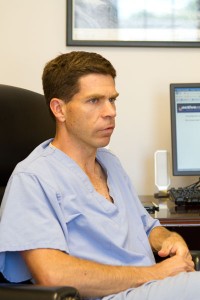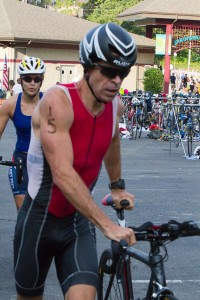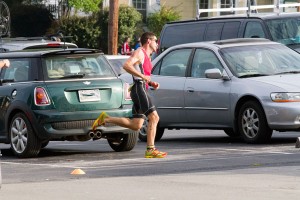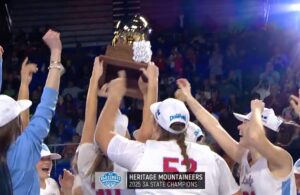The Iron Doc
BMH’s Almand joins ranks of triathlon elite
 Dr. Bond Almand, pictured here at his Maryville office, completed the course at the Ironman Triathlon World Championship on the big island of Hawaii on Saturday. Photos by Jolanda Jansma
Dr. Bond Almand, pictured here at his Maryville office, completed the course at the Ironman Triathlon World Championship on the big island of Hawaii on Saturday. Photos by Jolanda Jansma
By Stefan Cooper
Editor
Blount Press Row
Much of the advice any good physician dispenses is take better care of yourself, get active and stay active.
Under the heading of practicing what you preach, …
Dr. Bond Almand joined one of the most exclusive fraternities in all of sports on Saturday. The Blount Memorial Hospital doctor was among a select field of 2,100 entrants at the 35th annual Ironman Triathlon World Championship on the big island of Hawaii.
Almand covered the 2.4-mile ocean swim, 112-mile bike ride and 26.2-mile marathon along the Kona Coast in 9 hours, 51 minutes and 34 seconds, the husband and father of two earning the coveted “Ironman” designation in his first attempt at the Super Bowl of endurance sports.
Almand trained for a year for the event, a year, he said, where he often questioned his sanity.
“You’ve got to be a little crazy,” Almand said, “and you’ve got to be a Type-A personality. To really train for it, you’ve got to enjoy going out and suffering.”
Belgian Frederik Van Lierde blistered the course in 8:12.29 to take the overall, with Australian Mirinda Carfrae best of the women’s field in 8:52.14.
Not far back, Gordon Haller reached the finish to cheering crowds in 15:37.47, an impressive feat in its own right for the Walmart computer systems analyst. Haller, 63, won the inaugural Ironman in 1978, the event then held on Oahu. The celebrity now associated with the event was nonexistent then, he said.
On start line that day at Waikiki Beech were 14 others. Twelve finished the course.
“I remember standing on the shore with my paddler,” Haller said. “He said, ‘Do you think you can do this?’ I said, ‘Do you think you can?’”
Saturday, Almand and the others left the pier the very elite of their sport. Better than 60,000 hopefuls begin the qualifying process for the world championships each year, with 0.033 percent making the Kona cut.
Almond, 40, earned selection by winning his age group at the Ironman Texas last year.
The differences between then and now are many, Haller said. In 1978, his sponsor rented a $200 Raleigh from a local racer for him to ride. Almand’s sport-specific machine easily exceeds $2,000.
There was no banner over the road designating the finish line at the inaugural, Haller said, no finishing tape to break. When he made it back to Honolulu that evening, a race official sitting roadside with a clipboard broke the news.
“I said, ‘Is this the finish line?’” Haller asked. “He said, ‘Yeah, you’re done.’”
The one constant, he said, is the level of commitment necessary, and not simply from the competitor.
Almand said he’s always made it a point to stay fit, but, until a year ago, he’d never been much of a competitive athlete.
“I’d never won anything in my life until last year,” he said.
In May of 2012, Almond placed first in his age group, third overall, at the Foothills Sprint triathlon. First and second that year were a couple of 19-year-olds from Chattanooga. Almand said it made him wonder just how far he could go in the sport if he really pushed.
“I always wanted to do an Ironman just to do it,” Almand said. “I thought, ‘Maybe I can get a Hawaii slot.’ I realized if I buried myself in the training, maybe I could make it.”
Right from the start, he had an edge.
“I’m able to get off the bike tired and still keep going,” Almand said.
The transition from the bike to the run has always been the most crucial in the race, Haller said.
“I hadn’t really raced the bike before (in ’78), but I’d ridden hundreds and hundreds of miles,” he said. “I remember I got off the bike (at the Ironman), and I could hardly walk. I’d never felt like that in my life. I got off the bike and jumped in the Aloha Fountain to cool off.
“You get to the run and you’ve got no calories left in your body. After you’ve run a while, reality starts to set in.”
Haller, much like Almand, was also counting on the marathon to be an equalizer.
“I caught up with (the leader) at 15 miles and stopped to get a massage,” Haller said. “He looked really, really bad, staggering all over the place.”
At mile 21, Haller hit the gas and raced away.
The race itself is more than challenge enough, Haller said. It’s integrating the training with the rest of your life that makes the difference, he said. It was no different for Almand.
The life of a physician is taxing enough. Almand typically begins his day at Blount Memorial at 7 a.m. Most days, he’s already been on his bike for several hours.
“Bike rides are in the morning so I’m done before the kids get up,” Almand said.
A lot of soul searching took place during those pre-dawn rides.
“Early in my training I started playing with my numbers and wondering if I could really do it,” Almand said.
After clinical work at the hospital, Almand checks in at his office, less than a mile from the hospital grounds. After work and family commitments, there’s more training later that night.
“There’s a fine line between overtraining and not training enough,” Almand said. “You always push that limit.”
As Haller alluded to, it’s the family aspect of training for an Ironman that’s often underestimated, Dr. Ken Bell, a colleague of Almand’s at Blount Memorial, said.
“To do this you have to have a significant amount of family and work support,” Bell said.
Bell and fellow physician Eric Morgan teamed with friend and triathlete Keith Amos to form “Team Amos” when the latter made a successful bid for the Ironman Louisville a few years back. Morgan and Bell monitored Amos’ training and helped with technique. Amos’ wife, Brenda, and daughter, Hunter, ensured Keith had the time needed to train once he got home from work.
“I suspect they had a sit down and said, ‘Let’s let dad have this year off from normal stuff,” Bell said. “You’ve got to involve your family in it as much as you possibly can. I know when Keith did it Hunter would paddle the kayak next to him out in the water.”
At home, they just accepted things would be different for a while, Hunter said.
“I was the man of the house that summer,” she said.
To show his thanks to his wife and children for the past year, Almand made the trip to Hawaii a weeklong family vacation.
The sport of triathlon has seen explosive growth the last decade, the shorter distance sprint versions typically reaching max capacity within hours of the opening for registration. The local Springbrook Sprint, in which Almand took part earlier this summer, drew overflow crowds.
The Ironman distance remains the biggest draw, however, and for good reason, Bell said.
“The speed at which these guys do it!” he said. “It’s just crazy how fast these guys ride.”
Almand finished the bike split in 5:06.59, the swim in 1:11.42 and the marathon in 3:25.31.
Chattanooga is staging a first-ever Ironman event next year. Almand sat at his computer before leaving for Hawaii repeatedly hitting the refresh button during a half-hour interview.
“It’s frustrating because it’s not until next year,” he said, “and I can’t even register.”
Well, there’s always Hawaii.
Related Posts
About Stefan Cooper
Stefan Cooper is an award-winning sports journalist in Blount County, TN. Stefan has been writing about local sports for more than 25 years. In fact, he's writing stories today about the kids of players he used to write stories about. You'll spot him biking around town, hanging out at a coffee shop or Southland Books, or in his natural habitat: the sideline of the game.










You must be logged in to post a comment Login